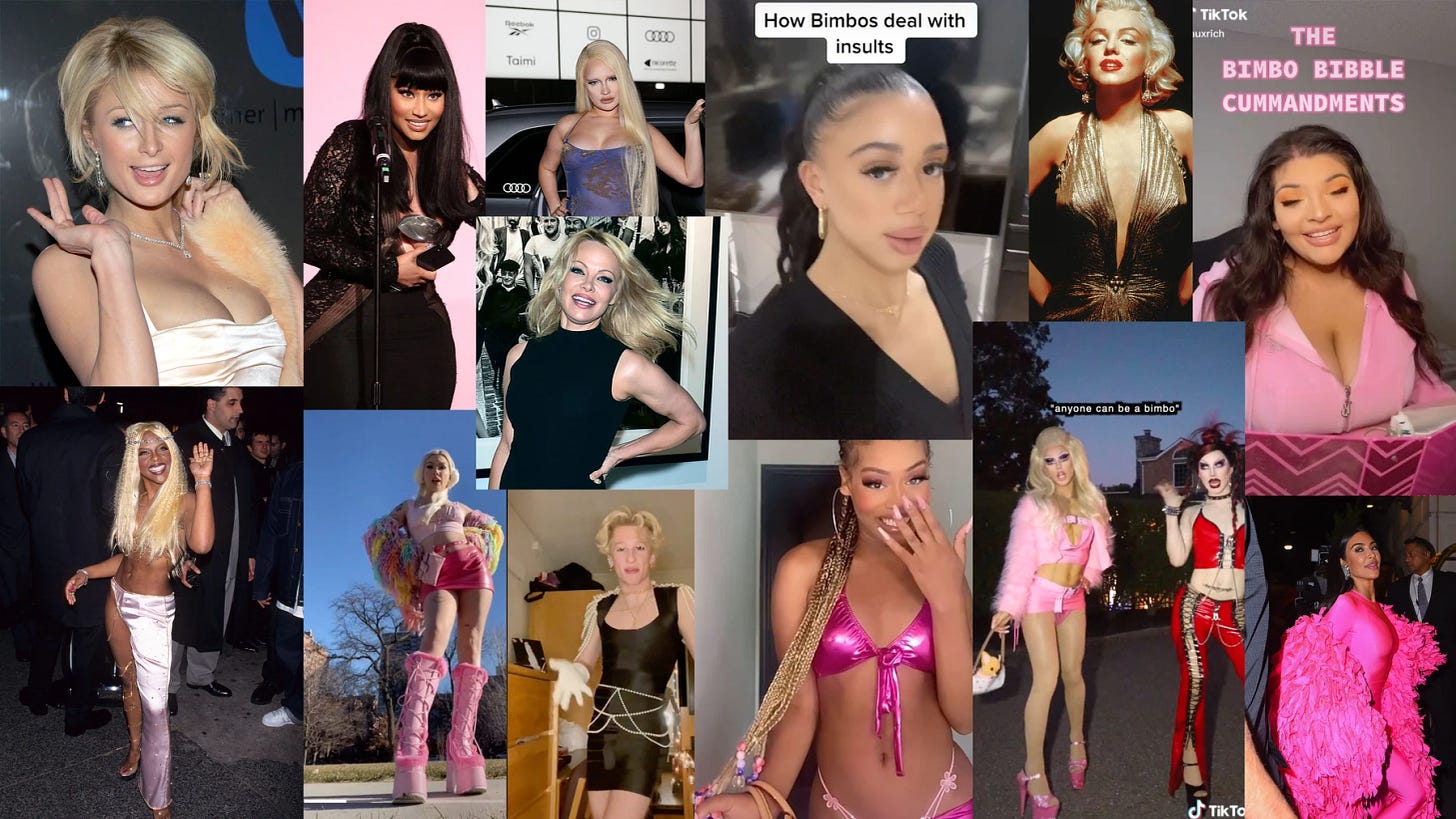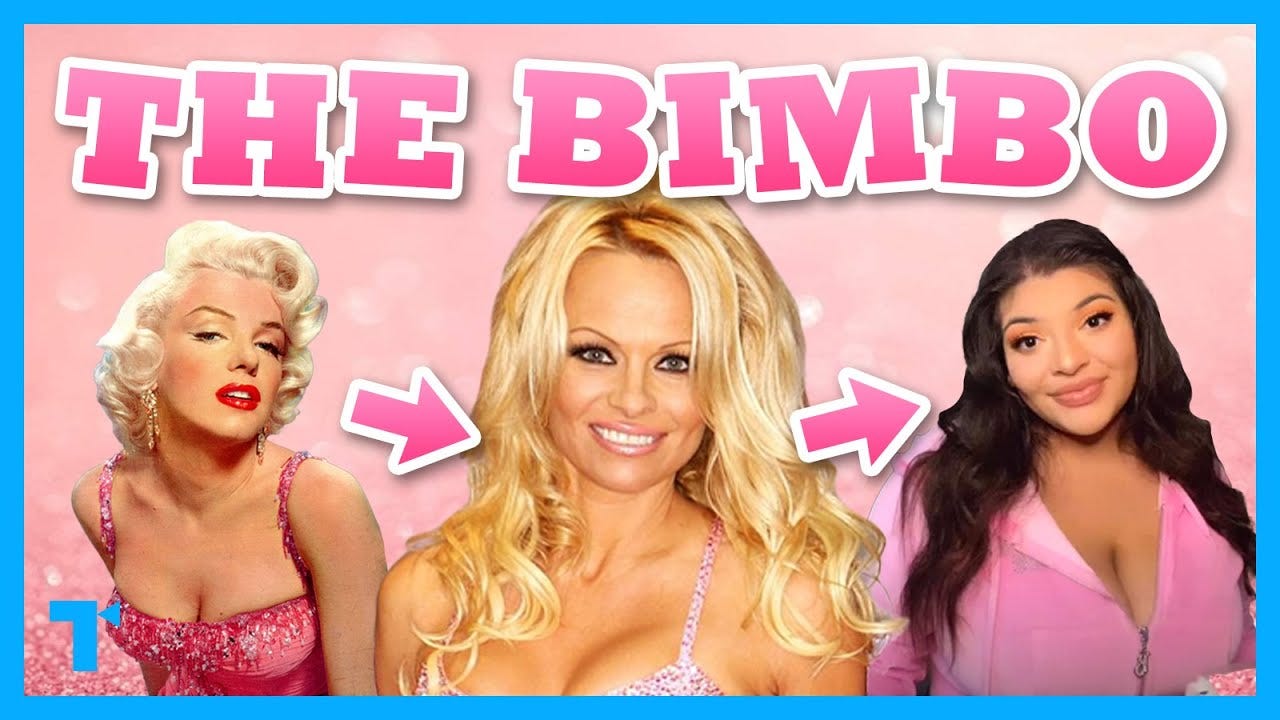what's up with bimbofication?
a critical analysis of the rising "bimbo movement" on social media and its potential for liberation (or lack thereof)
This article is adapted from an infographic originally posted here.
All over the internet, but on Tik Tok specifically, there is an increasing push to reclaim what some consider to be a misogynist slur: bimbo. The trend began in earnest when Tik Tok creator Chrissy Chlapecka decided to respond to dozens of comments calling her a bimbo by embracing and redefining the term. Although this reclamation started mostly as a joke, it became more serious when they and other users connected the term to leftist ideology, arguing that anyone can be a bimbo — regardless of gender, race, age, or appearance — as long as they love themselves.
"A bimbo isn’t dumb. Well, she kind of is, but she isn’t that dumb! She’s actually a radical leftist, who’s pro sex work, pro Black Lives Matter, pro LGBTQ+, pro choice, and will always be there for her girlies, gays and theys."
Chrissy Chlapecka in Vice
Of course, Chlapecka does match the archetype of a bimbo — women who are young, thin, conventionally attractive, hyperfeminine, and white. Yet, their initial Tik Tok opened the door for many other types of people to assume the label and build on what they call "bimbology". Bimbology is an aesthetic, ideology, and lifestyle. It’s fun and pink and flamboyant. It’s all about being hot and sexy on your own terms and choosing not to think so hard about things that bother you. But what is so radical about bimbology? What about representing oneself as a “bimbo” is so conducive to feminism / queerness / anti-racism / leftist ideology?

According to the Oxford Dictionary, bimbo is an informal and derogatory noun that means “an attractive but unintelligent or frivolous young woman.” Bimbofication, too, originated as a genre of fetish art wherein people, especially women, are transformed into hypersexualized caricatures of themselves with emphasized sexual features. While the genre is criticized online for promoting misogyny, the bimbo movement has taken it for their own use.
“A lot of people are saying I’m putting feminism back 50 years… Maybe instead of dedicating our time to people who want to misunderstand us no matter what we say or how we explain it, why don’t we just let them, and let the results at the end prove everything.”
Fiona Fairbairn in Vice
This is certainly understandable. It often does feel hopeless to face one’s enemies, especially if they minimize your personhood and reduce you into a mindless bimbo in the first place. Yet, I think that beyond the clever jokes, recycled aesthetic, and surface-level politics, “bimbology” actually does more harm than good.
In an article on her substack, Rayne Fisher Quann discusses Walter Bejamin’s essay The Work of Art in the Age of Mechanical Reproduction in the context of the MeToo movement, saying that “an oppressive structure ‘ sees its salvation’ in allowing the masses to express themselves freely in lieu of granting them their rights”. Rayne argues that while the movement offered women and survivors of sexual assault a brief catharsis, it resulted in little to no actual systemic change. I see the same thing happening with the bimbo movement.
It may feel good to focus on oneself and let the rest of the world melt away, but it ultimately accomplishes little. And, despite the movement's claims of inclusivity, who really has the privilege to do this? It's one thing to reclaim the label and make quips about being nothing more than a hot airhead to push back at hate comments. It’s a different thing altogether, though, to offer women and other oppressed groups a repackaged version of oppressive aesthetics and stereotypes as a replacement for real liberation.
There is nothing revolutionary about telling women and girls to prioritize their looks, purge their minds of any thoughts, and refuse to engage with the world. In fact, this advice feels more in line with patriarchal expectations than anything else. And, unfortunately, not thinking about one’s oppression does not make it go away.
One self-proclaimed bimbo, Syrena or @fauxrich on Tik Tok (pictured above on the left), makes a great argument:
“Men and misogyny have taken that [sic] and spun it into this cool-girl, ‘I’m-not-like-other-girls’ stereotype to now please men. No matter what we do, no matter what our feminism is, every single thing is often spun to please men.”
While she says this about other aestheticized forms of feminism, it seems even more true of a movement that encourages an exaggerated form of femininity that arguably aligns with men’s desires. Who benefits from women wanting only to be hot and sexy? What happens when women completely check out of the real world? Even if this makes some of us feel better about ourselves or more confident, this is only temporary — a stopgap solution to a systemic issue. Deriving value from appearance, whether or not one is trying to meet certain standards, is superficial and leaves you with nothing if (and when) your appearance changes.
Of course, it's unlikely that these are the actual intentions or goals of the leaders of the bimbo movement. A lot of their content is sarcastic or facetious, not meant to actually encourage vapidity. And if it's not harming anyone, what's wrong with having fun and enjoying yourself?
True, the trend is fun and seductive. And there’s a lot of truth behind what the leaders of the movement are saying. Taken with a grain of salt, their advice might be helpful to some. But at the same time, it's also being taken literally by quite a few people, even inspiring articles that declare bimbofication to be our new saving grace when we should be looking to the work of actual organizers. For younger, more malleable audiences especially, it has some serious implications. Should we really stop trying to better ourselves to focus on looking better? What exactly are we changing by reducing ourselves to what our enemies already think of us?
The logic of bimbology is frighteningly contradictory. It says neither what men want nor how you look matter, but it's obsessed with appearance and caters to male fantasies and desires. It says it's radical and revolutionary, but it's built on exclusionary tropes and old stereotypes. It says it's anti-capitalist, but promotes materialism. It says inclusivity is important, but then its main spokespeople, are white, thin, young, and conventionally attractive. They might criticize girlboss feminism, but they reproduce the same oppressive hierarchy and uncritical critical acceptance of the status quo.
If we’re to just sit back and let the "end results" of the bimbo movement speak for themselves like Fairbairn says, we’re in for a rude awakening when a nonsensical aesthetic fails to move us any closer to liberation. We need something better.
references <3
Fitzgerald, K. J., and Grossman, K. L. 2021. Sociology of Sexualities (2nd ed.). SAGE.
Fisher-Quann, Rayne. 2022. "who's afraid of amber heard?" Substack.
Lanigan, Roisin. 2021. "2021 is the year of the bimbo". i-D (Vice).
Richards, Arielle. 2022. "Bimbofication Is Taking Over. What Does That Mean for You?" Vice.
Santiago Cortes, Michelle. 2020. "Our Smooth Brained Future: The Rise Of The New Age Bimbo." Refinery 29.
Starkel, Martha. 2022. "Bimbofication is a revolutionary act." The Michigan Daily.





